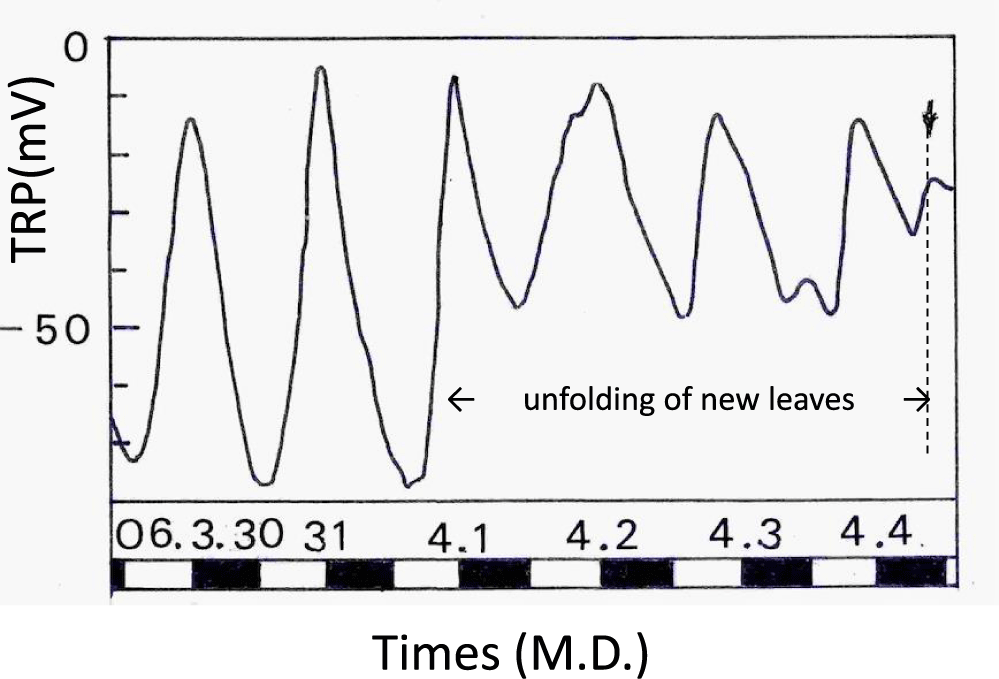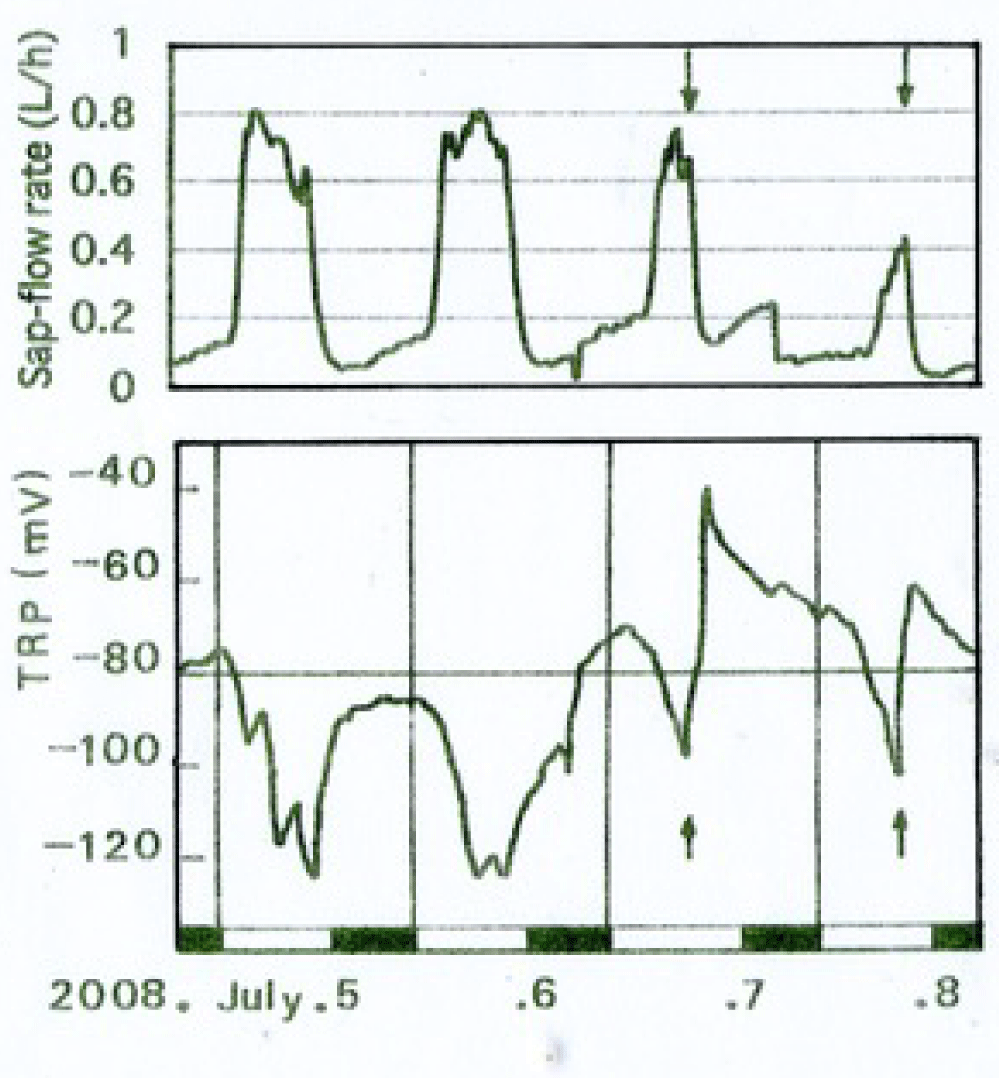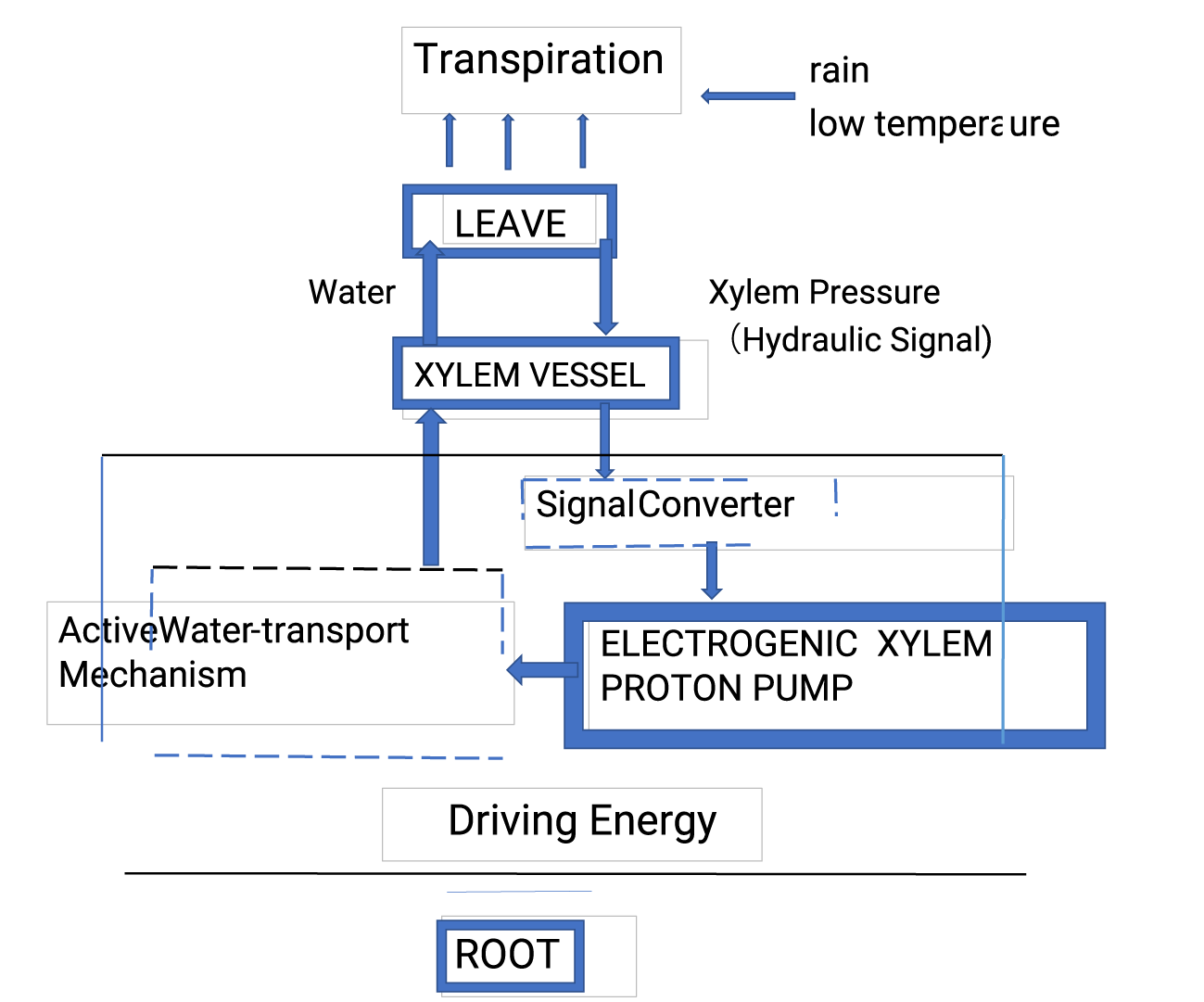Biology Group . 2022 April 20;3(4):355-357. doi: 10.37871/jbres1448.
Why and How the Bio-Electric Activity of Plant Roots is Awoken When the Leaves Need Water? A Very Rapid Signal Transmission from Aerial Part to Root
Hisashi Okamoto* and Sayaka Kitamura
The simplest and scientific method to determine the bioelectric activity of a plant root is the measurement of the Trans-Root Electric Potential (TRP) i.e., the electric potential difference between the xylem apoplast and the earth surrounding the root.
Observation of a tree TRP for a very long term is possible when a liquid junction is formed via an injection needle filled with dilute KCl aqueous solution stuck into the xylem apoplast (connected to the input terminal of an operational amplifier of high input resistance via unpolarizable Ag/AgCl electrode), while a liquid earth is set in the root-zone via the similar electrode [1].
During the above long observation on a kaki tree (Diospyros kaki Thunb) in the field, we became aware of the following two conspicuous phenomena
- The amplitude of the diurnal variation of TRP increases largely just prior to the tree leaf bud breaking when the transpiration activity is still low, and rapidly decreases after breaking of the new buds (Fig 1).
- When the leaf transpiration of the tree is inhibited by heavy rain or by sudden drop in air temperature during summer, a very rapid positive shift of TRP, occurs simultaneously (Fig 2).
These phenomena suggest an intimate relationship of active transport of water and the bioelectric activity of root, and also a very rapid signal transmission from leaves to roots. Based on these observations, we established a hypothesis that the signal should be the lift of the xylem hydraulic pressure (transmitted for a long distance with a sonic speed through water) (Fig 1 [2]) .
We constructed an apparatus which enables simultaneous recording of TRP and artificially applied xylem pressure (Fig 2a [2]) , and demonstrated the positive shift of TRP (upto 80 mv) with the application of the excess xylem hydraulic pressure (up to 100 kPa) in the seedlings of all the 11 tree species examined (Fig 3 [2]) .
This reaction is season-dependent, as it was not observed in winter, but most vigorous in summer.
- What does the positive shift of TRP indicate?
To answer this question, we analyzed the data using the “theory of the electro-physiological structure of the plant axial organ”, developed during 1978 ~ 1984 by the research group in Nagoya University, Japan.
The TRP has the following structure (Fig 2b [2]) .
TRP = Vps – Vpx (= Vxs)
Vps: Electric potential difference across root surface side symplast membrane, more than -100mV; the larger half is generated by the activity of the surface-side electrogenic proton pump (The residue is the equilibrium potential of K+ across cell membrane).
Vpx: Electric potential difference across root xylem side symplast membrane, more than -100mV in cold season, the larger half is generated by the activity of the xylem side electro-genic proton pump, which decreases during hot season when the transpiration is vigorous (pumps go into resting state) [2].
Theoretically, the positive shift of the TRP occurs during the activation of the xylem proton pump (hyper-polarization of Vpx), or “inhibition of the surface proton pump” (de-polarization of Vps) which although seems to be too unnatural from the view point of the plant life strategy (Fig 2 [2]).
We found solution to this problem by means of the intra-cellular micro-electrode technique; by the simultaneous determination of the change in Vps and in Vpx caused by the application of the excess hydraulic pressure. Throughout 15 experiments, no inhibition of the surface pump was observed. Just the xylem pump was activated in its resting season (i.e., except winter) by the hydraulic signal [3].
| Appendix: Comparison between the velocities of bio-signals. | |||
| Mechanism | Velocity (m/sec) | Receptor | Effector |
| Action potential Charophyte Mimosa petiole Animal Neuron Variation pot. of Higher plants Hydraulic signal In higher plants |
0.04 ~ 0.4 0.04 3 ~ 1000 0.01 ~ 0.2 30 ~ 40 1500 |
Inter-nodal cell Leaf Sensory organ Leaf Root Root Leaf |
? Pulvinus Muscle Leaf (peptidase- Inhibitor gene) ? Leaf (guard cell) Root (Xylem H+ pump |
This activation did not take place under anoxic condition, showing it is the “pump phenomenon” in its primary meaning but not the channel phenomenon.
Conclusions based on the observation are summarized in figure 3, where the established fact is surrounded by the continuous line, while the problem for future molecular physiological research is indicated by the discontinuous line.
References
- Okamoto H, Masaki N. Long term measurement of the trans-root electric potential in a persimmon tree in the field. J Plant Res. 1999;112:123-130.
- Okamoto H, Kitamura S, Masaki N. Activation of the root xylem proton pump by hydraulic signals from leaves under suppressed transpiration. J Plant Res. 2022 Mar;135(2):311-322. doi: 10.1007/s10265-022-01368-x. Epub 2022 Jan 25. PMID: 35075591.
- Volkov AG, Brown CL. Electro-chemistry of Plant Life In:Volkov A.G. ed Plant Electro-physiology: Theory and Methods. Springer, Berlin, 2006;437-459.
Content Alerts
SignUp to our
Content alerts.
 This work is licensed under a Creative Commons Attribution 4.0 International License.
This work is licensed under a Creative Commons Attribution 4.0 International License.











